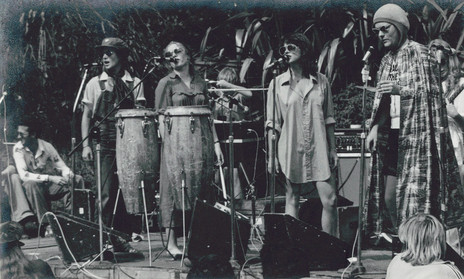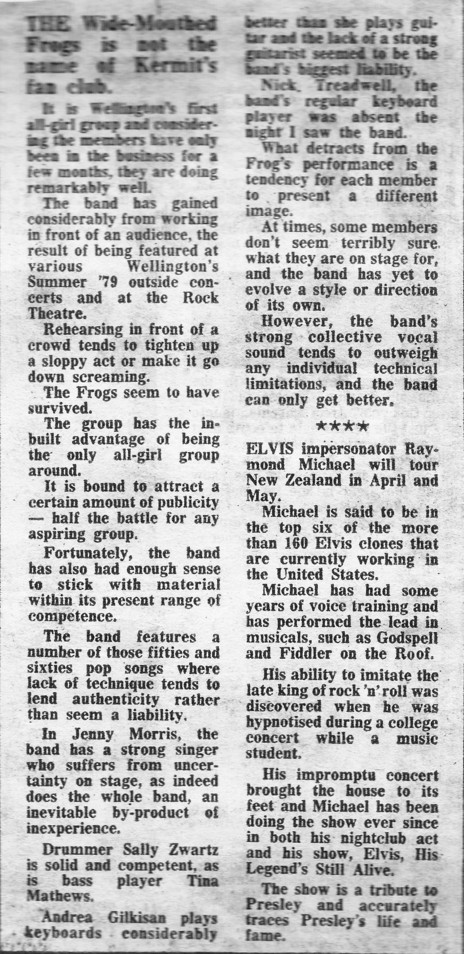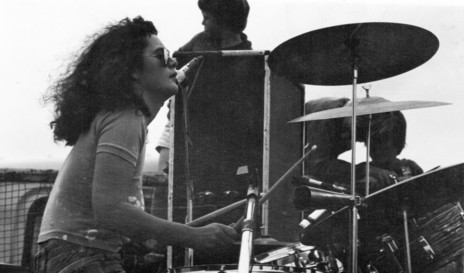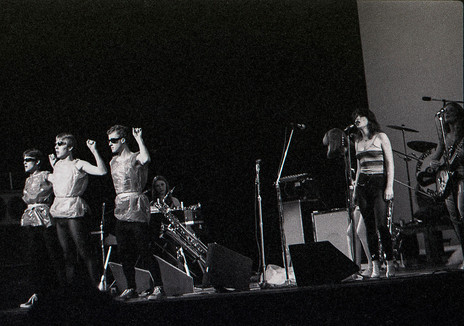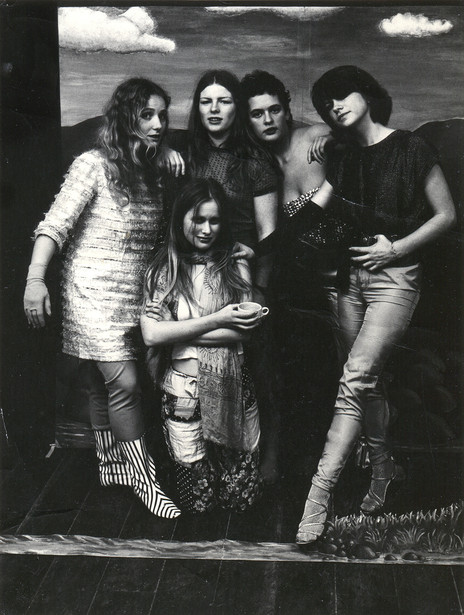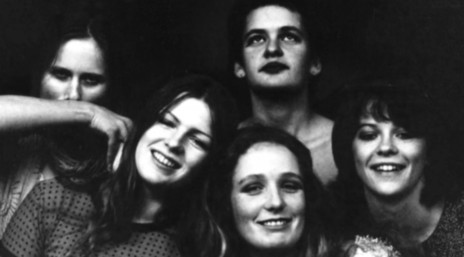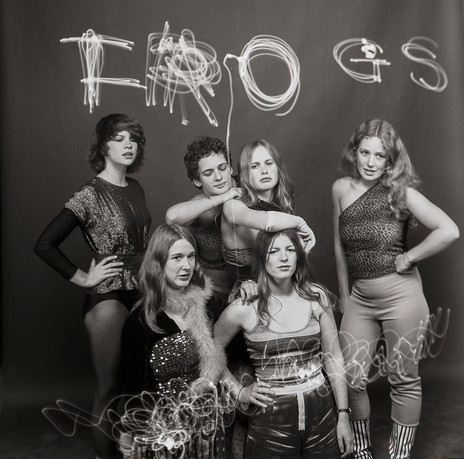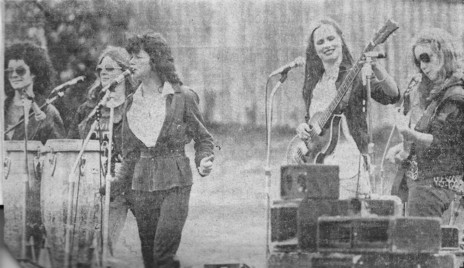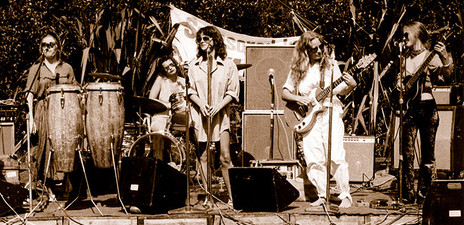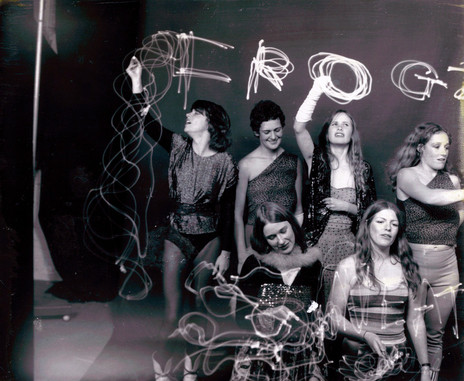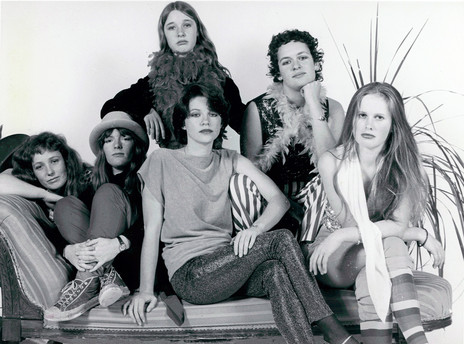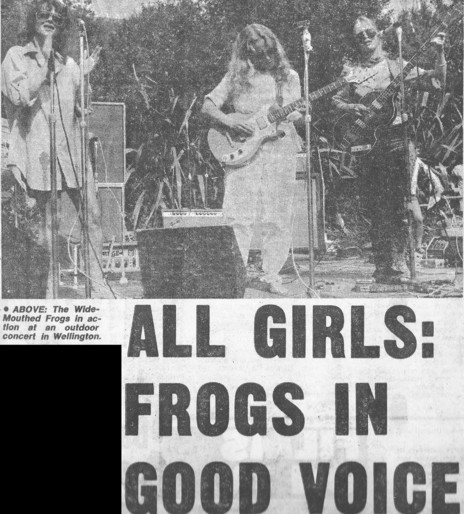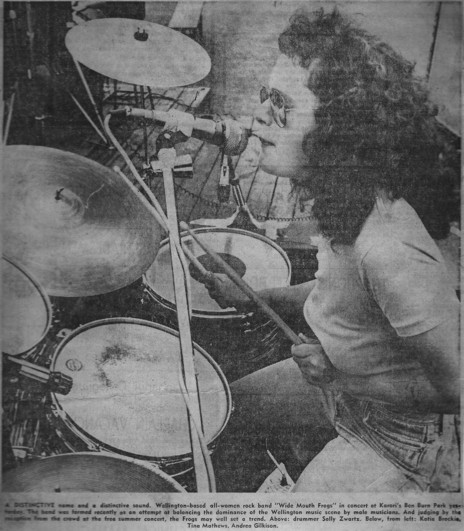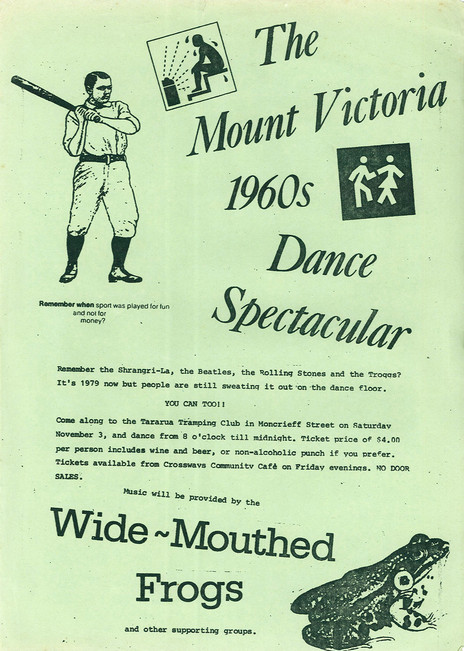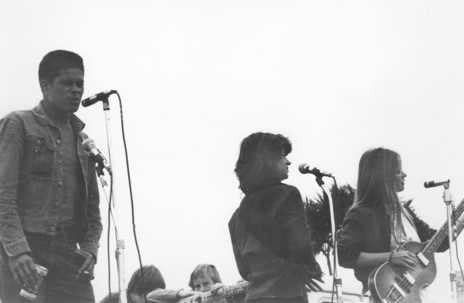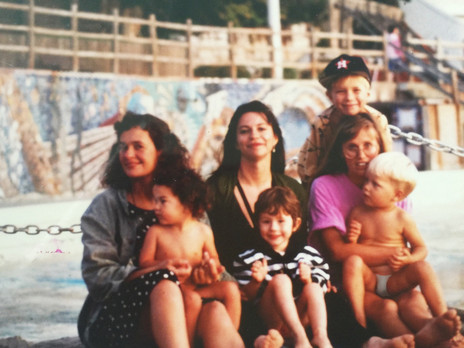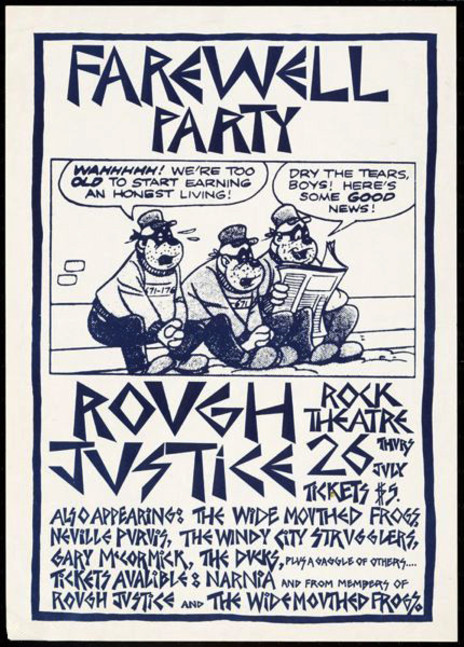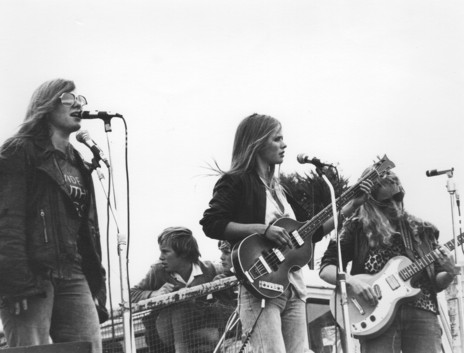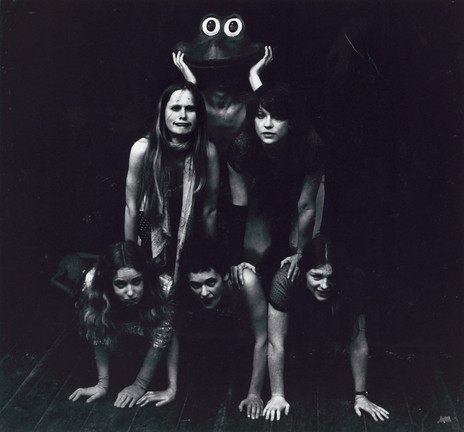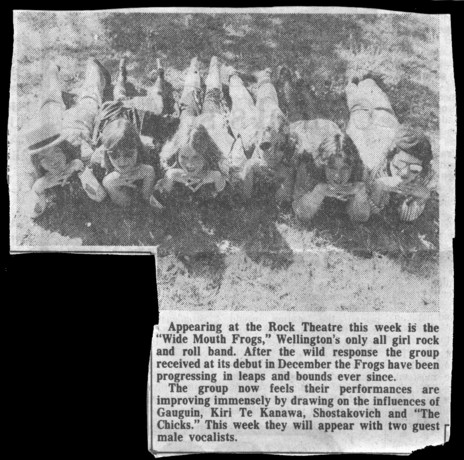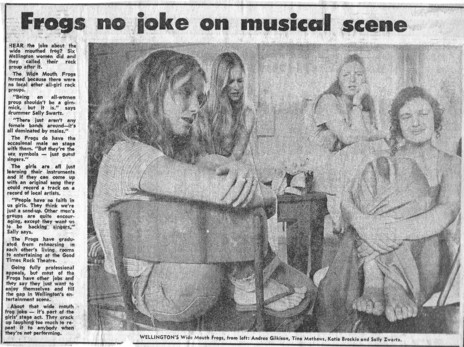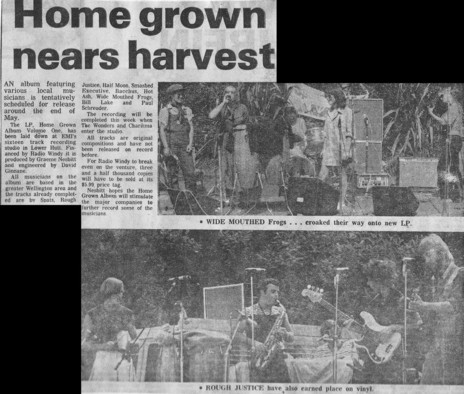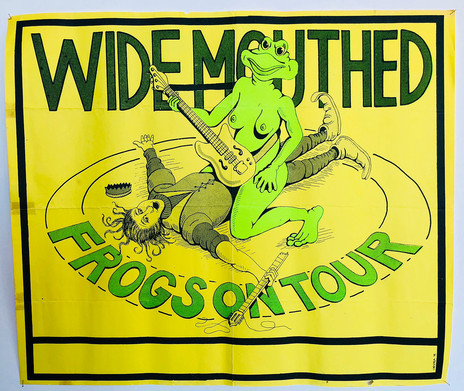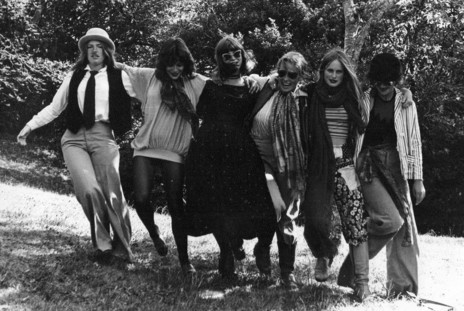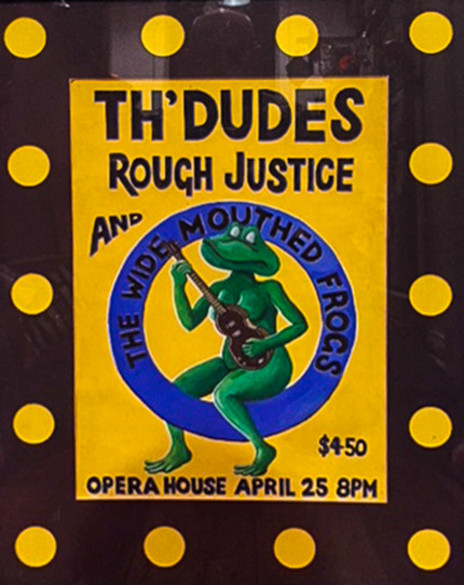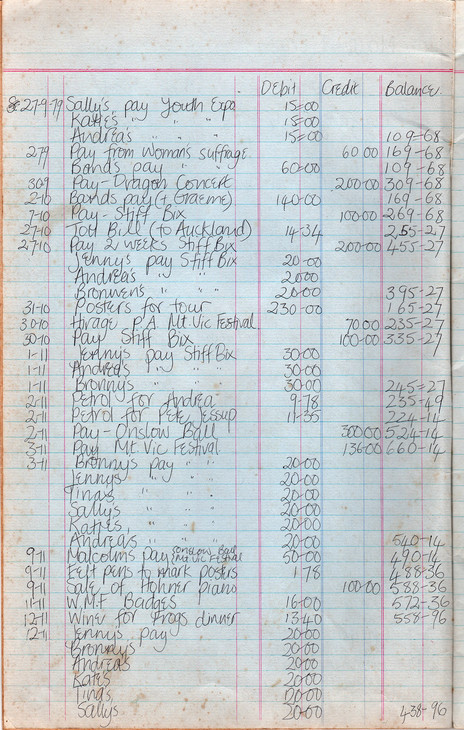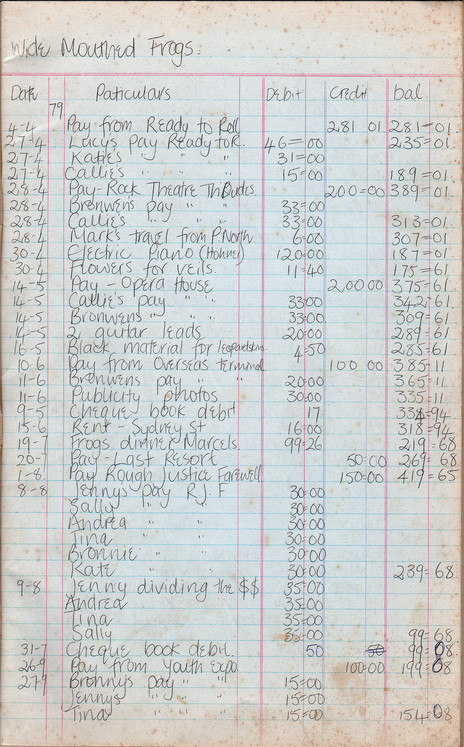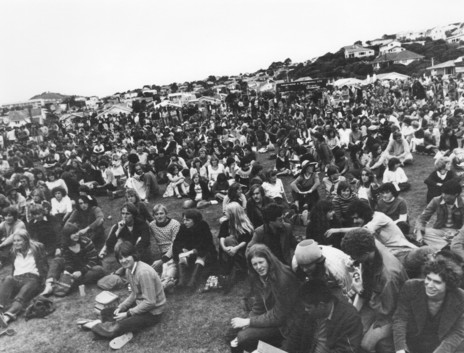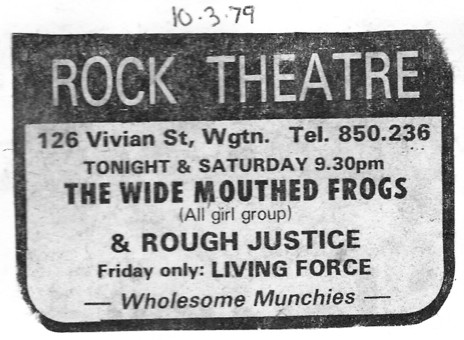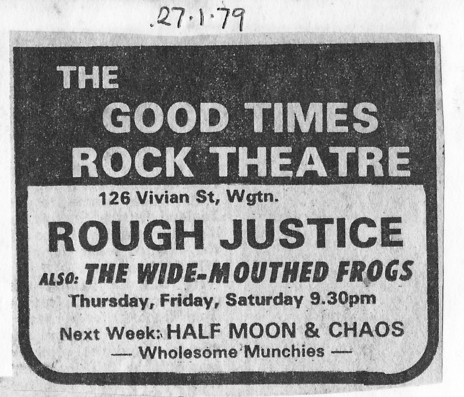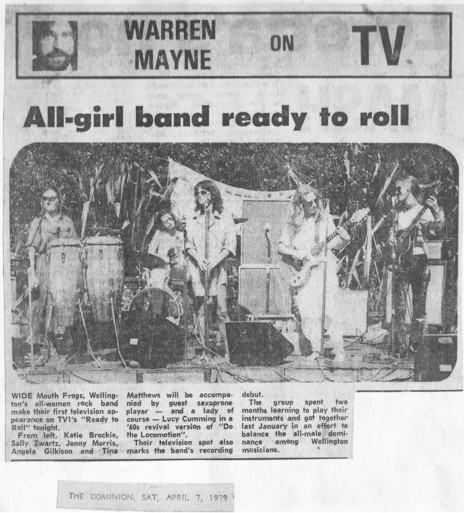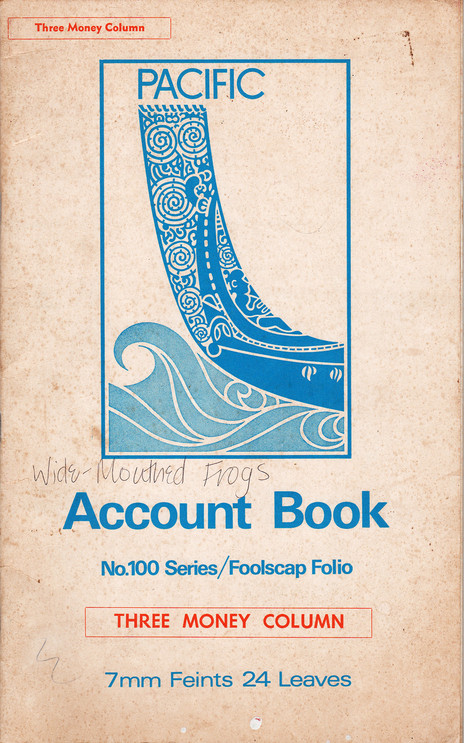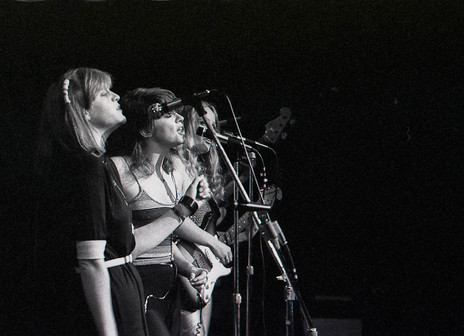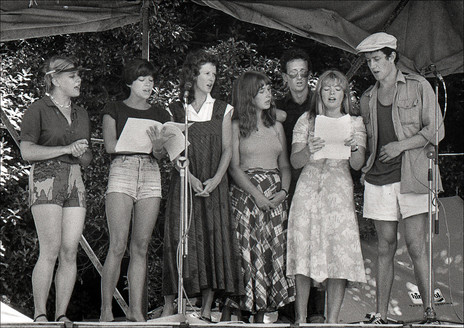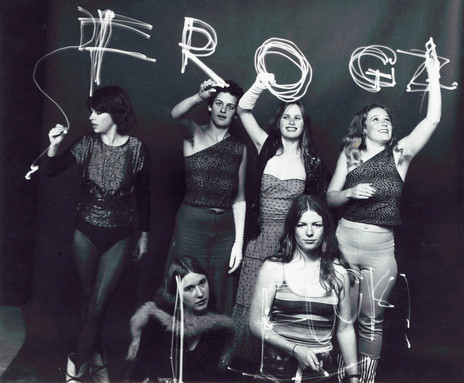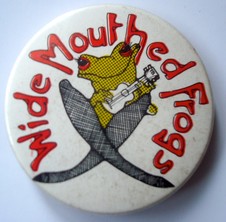The WMF were, as far as I knew then, New Zealand’s first all-female rock/pop band. We were a six piece, mostly: Jenny Morris and Katie Brockie (lead vocals), Andrea Gilkison (guitar), Bronwen (Bronnie) Murray (keyboards), Tina Matthews (bass) and me (drums). We came together in late 1978 and did our first gig in December that year. Our last was at the inaugural Sweetwaters Festival, in January 1980. The precise details of our history are hazy in parts and there’s remarkably little documentary evidence to turn to – we have a few newspaper clippings and, luckily, the WMF accounts book, meticulously kept by Andrea. So, for this telling I’m relying mainly on an exercise of collective recall by the six of us, with additional help from others who were there. There are some gaps but overall that process of remembering produces a narrative of unusual unanimity. Which is a very fair reflection of what it was like to be in the band, all those years ago.
THE WIDE MOUTHED FROGS WAS A YEAR OF ALL-ABSORBING FUN
There’s no question, for instance, about the genesis of the group. We loved music. Music was big – that’s how Katie describes it. We went to hear Wellington bands all the time. Our male friends, housemates and/or boyfriends were immersed in a world of music and music making, and we saw close up how engrossing and rewarding the project of music was. Not financially – that’s probably so obvious it doesn’t need to be said – but in all other ways. We wanted to experience that for ourselves. At least that’s how it was for Tina, Andrea and me – so we decided to start a band.
We already knew Katie. She was an actor, working at Centrepoint Theatre in Palmerston North at the time and visiting Wellington most weekends. When she heard about the band she was immediately keen to be involved. Mutual connections led us to Bronnie, a classical music student, and to Jenny, then a high-school teacher. “I was seduced by three comments Tina made,” Jenny says. “1) All girl band. 2) Lots of harmonies. 3) Lots of cups of tea.”
All of us had music in our growing up. Tina, Andrea and I had all learned piano. Bronnie had learned piano and was still learning it, now at Victoria University. Jenny learnt violin “for five minutes” at intermediate school and had another brief moment learning piano when she was about 10. “Then my sister bought me a guitar when I was 12. I had the Carole King Tapestry music book, taught myself to play and became a songwriter at that point.” Katie: “I’d been in a band, which mainly played Stones covers. But we also did some original songs. I’d also been in the school choir, and other choirs, where I vaguely learned to read music. I knew I could sing in tune, and I knew that I really enjoyed singing (and still do).”
Singing was something we shared. Jenny, one of seven siblings, recalls singing with her family on road trips. “We always sang and did little concerts. Family harmonies gave me my love of performing.” Bronnie had always sung in choirs, and when it came to the band, “I loved the backing vocals even more than playing,” she says. I’d grown up singing at home, and had been in choirs at school. All of us were pretty comfortable working out harmonies and holding a part. It led us to a certain kind of repertoire, as Andrea recalls: “We all liked lots of 60s stuff, and those songs were quite simple and had lots of vocals – vocals were clearly our strength.”
Two great singers, some decent backing vocals, a piano player. Almost a whole band.
“All we needed were instruments – so we borrowed those and set about trying to play them,” says Tina. She picked up the bass and Andrea the guitar, while I got started on the drums. “Which instrument we each played was pretty hit and miss,” Andrea says. She thinks she might have started out on drums, and then opted for guitar instead, which she’d played a bit before. I was pretty happy to end up on the drums – partly the pleasure of playing them, and partly because the kit gave me something to hide behind.
We took the band name from a joke going around at the time
We also needed a band name, and we took it from a joke going around at the time: A wide mouthed frog went for a walk to find out what other animals liked to eat. First of all, it met a turtle. “Who are you and what do you eat?” asked the wide mouthed frog. And so on, culminating in: “Who are you and what do you eat?” asked the wide mouthed frog. “I’m a snake and I eat wide mouthed frogs.” “Oh! Seen any around lately?” Thomasin Bollinger, our friend and early manager, recounted it to an enthusiastic audience at our very first gig.
All of us remember that while what we wanted was to enjoy ourselves, there was also a point to be made. We were an all-female band because there were so many all-male ones around us. We wanted to show we could do it. “I think we would have called ourselves feminists and there were very few women in New Zealand bands, so we were obliged to change that,” Tina says. And Jenny: “I remember a strong feeling of wanting to stick it up the blokes. I feel like we knew that what we lacked in expertise we could more than make up for in music awareness and knowing what audiences would like and appreciate and how to give that to them.”
But the main thing was the fun. Having fun, poking fun. And, fortunately, in entertaining ourselves we also entertained others, which is surely not always the case.
Here are some eye witness accounts of our very first gig, December 1978.
Barry Thomas, a Wellington artist who in 1978 co-founded the Artists’ Co-op, a studio, exhibition and performance space housed in an old Wool Board warehouse on Thorndon Quay, remembers our debut took place there. “It’s printed indelibly in my brain,” he says. There were no seats, everyone brought cushions and sat in the round. He’d invited the band to play, and it also fell to him to introduce us – “Ladies and gentlemen!” – like at a boxing match, he recalls. “It’s my role in this small bit of history. But it was a lovely thing, because they were just really liked and applauded all the way through their four songs or whatever it was.”
Barry was speaking to his friend Rowan Saker, who recalls the gig was at the Rock Theatre, behind Trade Union Hall in Vivian St. “The lights were low and I cannot remember if they were headlining or not. I knew one or two of the Frogs of course – Andrea Gilkison from school days, and Tina, a long-time family friend. They marched on in colour coordinated sequin outfits; I think Jenny Morris was in blue, I think Tina was in green and Andrea in a sort of pale pink from memory, but I can’t remember exactly … They were magic that night. I think they blew a lot of people away. No one had ever seen anything quite like this … They seemed destined for great things.”
Paddy Neville, who at subsequent performances joined us onstage as a singer, remembers the gig as “amazing and totally successful … the whole band an instant hit.”
Nick Bollinger, Rough Justice bass player, my housemate and Tina’s boyfriend at the time, writes in his book, Goneville:
“When they had half a dozen songs ready, the WMF were ready to face the crowds. Rough Justice agreed to let them play an opening set at Rock Theatre in Vivian Street. They caused a storm. There were then few women in bands doing anything other than singing. Here, for the first time as far as most audiences were concerned, was a group of women doing it all – singing, playing, the lot. Their choice of covers was simple and appealing. There were no gratuitous solos; no song outstayed its welcome. They were funny, irreverent and loved being on the stage. When they opened for us again a few weeks later, the venue operators, sensing who the real drawcard was, reversed the billing in the newspaper ad. Now it was WIDE-MOUTHED FROGS – ALL GIRL BAND! ‘Rough Justice’ appeared in tiny type below.” (p208)
On the set list was a punk, feminist version of ‘Itsy Bitsy Teeny Weeny Yellow Polka Dot Bikini’
It’s clear our arrival on the somewhat drab Wellington musical scene had an immediate impact. We did four or five songs at that first performance: ‘Do The Blue Beat’, ‘The Loco-motion’ and ‘Love Potion No. 9’ were definitely among them, perhaps also ‘Runaway’ and ‘You Can’t Hurry Love’. Eventually the song list grew to include a quantity of mostly 60s pop songs, R&B songs, a few originals and some eccentric others. Katie was our heartfelt, bluesy soul singer – ‘Midnight Train to Georgia’, ‘Piece of My Heart’, ‘When a Man Loves a Woman’; Jenny was pure pop and, because she could do anything, everything else. ‘Leader of the Pack’, ‘Chapel of Love’ and ‘Da Doo Ron Ron’ were on the list, also a punk version of ‘Itsy Bitsy Teeny Weeny Yellow Polka Dot Bikini’ – “a must for feminists”, as Tina describes it; also songs by Dan Hicks, the Cars, Frank Zappa, Randy Newman, The Beatles, and Blondie. Tina: “We made some hilarious and surprising choices – but I think we knew our limits and tried to do songs where the harmonies would carry us through.”
As time went on we also featured special guest singers, generally introduced as our token sex symbols: Paddy did ‘Twist and Shout’ and Paul “Mac” McAllister did a great soulful version of ‘Hit the Road, Jack’. Paddy remembers getting dressed up for an outdoor gig at Wilton Park in a “spectacular kitsch cape” and for another gig in “very cheap crap glam stuff and a crazy beanie Nick Bollinger gave me that had red rabbit ears and a hole in it that I’d thread a big tress of my (very long) hair through.” He’d been a proud fan of the band, he says, and when he got his “sex symbol slot” he felt “Wow, I'm part of this – so yeah, I loved it.”
The band got dressed up too, in gear of all kinds: sequins, froggie green tuxedo jackets, hot pants – part silly and part effectively eye-catching. Tina: “Dressing up was an essential aspect of the performance and very bonding.” And Andrea: “Dressing up was always the best bit for me – velvet hotpants, the tinsel dress, the bridal veils [for ‘Chapel of Love’] … some of those outfits I still have and have been worn by my kids … and probably my grandchildren soon!”
Our performances were completed by the occasional addition of three male go-go dancers, sexy as hell – Mark Cubey, Kevin Hinchey and John Bowden – who gamely dressed in black rubbish bags and not much more and jived energetically in front of the band. In all, for Wellington bands at the time, the WMF paid unusual attention to stagecraft.
Occasionally the group was joined on stage by three male go-go dancers, “sexy as hell”
Paddy points out that in a way we were a product of the moment. “Well, I think UK punk had a bit of an influence in as much as that encouraged the attitude of anyone should/can make music. Don’t have to be a virtuoso player. Ironically a lot of the Frogs were classically trained, eh? However, humour was a big factor, so a theatrical, gleeful but affectionate piss-taking component became kind of crucial to the eventual ‘image’.”
Locally, too, we found ourselves in a context that supported what we were doing. Barry Thomas, who’d created the Cabbage Patch art/nature installation in Wellington earlier that year, describes a “foment of creative shit” going on in Wellington at that time, due in part to new national and local government funding for projects in the arts sector. The Artists’ Co-op was one of those – “We employed 14 people,” Barry says – and so was a Wellington City Council programme that hired unemployed artists, actors and musicians to create events and performances around Wellington. “What a damn pity we haven’t got that kind of thing these days ... Artists have never been better off, in my humble opinion,” says Barry.
The unemployed artists programme – it was known as the scheme – hired Tina and me, and eventually the whole band. The person doing the hiring was the director of the programme, Graeme Nesbitt, who also became the WMF manager. He was someone who made things happen and got stuff done and we became the beneficiaries of that, and of his enthusiasm and experience.
Through the scheme, and/or Graeme, all sorts of opportunities opened up. We sang madrigals at the railway station during rush hour. As the WMF Orchestra and Chorus – with Peter Dasent as composer and musical director and Bruno Lawrence on alto sax – we were the house band for the Stiff Bix Cabaret, an initiative that brought many scheme actors and musicians together for regular performances at the Rock Theatre. We performed in parks over summer. And we got other gigs as well. Those itemised in the WMF accounts book include one at the Opera House ($200), at the Rock Theatre with Th’ Dudes ($200), at the Overseas Terminal ($100), the Last Resort ($50), Youth Expo ($100), the Onslow Ball ($300), Mount Vic Festival ($136), and Rough Justice’s farewell concert ($150). Graeme got us a spot on Ready To Roll, and for that we got paid $281. For Sweetwaters, the last gig listed in the book, we got $500. Graeme also made sure we were on the compilation LP of Wellington bands he produced for Radio Windy, Home Grown Vol 1. Our song, ‘Some Day’, was written by Tony Backhouse.
Outgoings included paying ourselves, equipment hire, petrol, publicity materials such as badges and posters (also felt pens to write on the posters – $1.78), and other more particular expenses such as flowers for veils – $11.40, and black material for leopard skins – $4.50. There’s also food and drink: wine for Frogs dinner – $13.40, groceries – $5.38 and, extravagantly, champagne ($20.10) and lunch ($66.45) for Graeme’s birthday. And, good lord, there’s even “Sending Telegram – $2.08”. (We think the telegram may have been sent to a friend recovering in hospital from an operation on his haemorrhoids – “Piles of love!”, it said.)
Graeme’s birthday lunch was at the end of November 1979, and the band was on tour at the time: Napier, Gisborne and Hamilton and then finishing up in Auckland where we played at Mainstreet. It’s likely the economics of the tour were pretty poor: in the accounts book Andrea notes that income from our two gigs in Hamilton (where we played at the Hillcrest) was $319 one night and $425 the next, while hiring gear and a PA was $750. But we had a great time. “We had the best roadies,” Katie recalls – Mike Knapp, Bruno and, briefly, Fane Flaws. And as always, there was an element of imitating the grownups: Katie remembers getting raided by the police in Gisborne – “we felt like we were a real rock and roll band,” she says.
Getting raided by the police in Gisborne, “We felt like a real rock and roll band”
We were support band for Th’ Dudes in Auckland. Jenny: “Th’ Dudes were very interested in us but I suspect not for our musical prowess.” We were also the support band for Dragon – a gig in Lower Hutt that hardly anyone came to. And, as Tina remembers: “Famously, Split Enz asked us to tour with them as their support act and we said we had better things to do – like disband (so punk of us).” In general, the bands we played with were tolerant, though somewhat nonplussed. Katie: “Most bands were pretty supportive, and were actually surprised at how good we could sound.”
We also had a lot of help from individual musicians, especially Tina, Andrea and me in our efforts to learn our instruments.
Andrea: “My proficiency at guitar was zilch to be honest, I relied on learning the parts from each song as we learned it. I could work out the chords okay; I do remember [Rough Justice guitarist] Stephen Jessup teaching me some riffs, and the blues – I think Fane Flaws may have taught me the Cars song, ‘My Best Friend’s Girl’, we did.” And Tina: “Nick taught me how to listen to the bass and showed me things about playing and tuning – and he lent me his bass. He was a great player himself, so that was a precious start. I bought books from the amazing player Carol Kaye and learned some of her bass lines.”
I learned from Martin Highland, and Steve Garden, and Bruno. A solid pedigree. And I practised hard, especially with Tina – we were serious about being a tight rhythm section. But, that old imposter syndrome – I never felt I could actually really play the drums. The gap between what I listened to and what I could play seemed insurmountable. I couldn’t play fast, and I struggled with dotted rhythms. Bronnie also suffered from self-doubt: “I felt like an idiot,” she says, “because I couldn’t improvise my breaks, had to plan them carefully and they were always the same. A lot of the time I felt like a big fraud.”
Am I good enough? It felt like a question the men around us didn’t stop to ask – for them it wasn’t the point (I accept I may be wrong about that). Answering it now I’d say yes, we definitely were. Partly that’s because as a group we functioned so well: everyone got on, we weren’t hierarchical, no one was in charge and, as Tina says, “there were no hungry egos”. Jenny: “I think there was a large element of pleasing ourselves first and foremost, and in doing that, we pleased the audiences.” Katie: “I think we entertained people really well. And (this sounds corny), I think we all became more confident and empowered by being in the band.”
As well, and I should have mentioned this earlier, Jenny was exceptional. “It was pretty obvious straight away that Jenny was a fantastically gifted and special singer,” Paddy says. As Nick observes, compared to other Wellington musicians, “Jenny had more idea really, more focus, about where you could go … She could project herself into that world that we saw on TV, of successful bands – I think she could actually see, ‘I could do that, I could be there, doing that.’” She was fearless, she sang like a marvel, she commanded the stage and – for a while, at least – she took the rest of us along with her.
At Sweetwaters in 1980 where the WMF did their last gig, a band called The Crocodiles also performed. Along with Fane Flaws, Tony Backhouse, Peter Dasent and Bruno Lawrence, the line-up included Jenny as lead vocalist and Tina on bass. They’d been head-hunted. The WMF”s exhilarating journey was over. It was drawing to an end anyway: Andrea was studying and caring for her young daughter Emma, Bronnie was due to leave New Zealand to continue her studies overseas, and Katie had an acting career to pursue. So the band had a life of just over a year, probably the right amount of time, not too long or too short. Though ask us now if there are any regrets and the answer is that we wish it had gone on for longer. Jenny: “I haven’t felt solidarity like that with any other musical iteration I’ve been involved with. It was like we were Musketeers. The fact that Tina and I are still talking about the Frogs on our beach walks, 40 years later, means something.”
“It was like we were Musketeers” – Jenny Morris on the Frogs’ solidarity
Celia Donovan was about 15 when she saw the WMF. Her family lived in Karori, very near to Ben Burn Park where every year the Rotary Club put on a fête – a highlight in Celia’s year.
“This year there was a stage and there was a band playing, and it was a band called the Wide Mouthed Frogs. And it was extremely exciting. 1. because I knew what the joke was, and 2. I’d never ever seen an all-girl band before. Never. And I’d certainly never seen a girl playing the drums – that was one thing. And the only chick I’d seen playing guitar was Susie Quatro … So anyway, on the stage, all these girls were thrashing away, playing ‘Loco-motion’ – which by the way was a very girly song, a little bit disappointing – but so exciting to see all these girls playing! There was this little skinny blonde woman playing bass, and the lead singer who had a massive voice – and it was amazing. And it kind of was like oh my god, girls can play rock music, and it’s not punk but it’s quite close to – and I ended up being this insane fan girl, going to every gig ever … It was a really big deal for me, that gig. And me and my friends formed our own band after that. We called ourselves the Lamé Budgies, as opposed to the Lame Budgies, and we wrote music, and I was the nominal drummer. We never played anywhere but we thought, we’ll be a girl band as well.”
That feels like a legacy. As does the lifelong friendship of the band members. I spent this morning practising – not the drums, I haven’t played those in a while. I was practising riding a bicycle, because to celebrate our 40th anniversary most of the WMF are going on a cycling holiday. We’ll miss the ones who aren’t there, but we’ll be thinking of them, and we might sing a song or two, and we’ll definitely be eating biscuits and drinking cups of tea and having fun like we always did, 40 years ago.
--
Callie Blood, a member of the Frogs' extended family, recalls the group.
